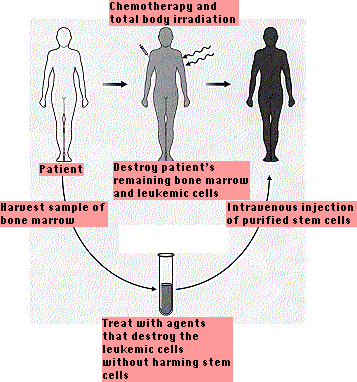They reside in the bone marrow and can be harvested from it. However, a few infusions of granulocyte colony-stimulating factor (G-CSF) — available thanks to recombinant DNA technology — causes them to be released into the blood where they can more easily be collected.
They are used to treat a variety of ailments includingHigh doses of chemotherapy and radiation can be used to kill off the cancerous cells in a patient, but they also destroy the patient's bone marrow, and the patient will die without a transplant of hematopoietic stem cells.

These can be:
Allogeneic stem cells
| In one remarkable case, an AIDS patient with leukemia was given a bone marrow transplant from a donor whose cells did not express a functional version of CCR5 — a coreceptor needed by HIV to infect T cells [More]. Two years later, the patient was not only cured of his leukemia but of AIDS as well. |
| If the patient's own marrow was not completely destroyed, the donor lymphocytes and the patient's lymphocytes can exist together. Then a later infusion of the donor's T cells may be able to kill off all the patient's remaining malignant cells leaving the patient with a bone marrow that produces donor-type cells exclusively. [Link to further discussion] |
So hematopoietic stem cell transplants (HSCT) can be life-saving but create their own problems. (Another example: an "immediate"-type allergy like hay fever or asthma of the donor can create the same allergy in the recipient.)
| Autologous hematopoietic stem cell transplants also show promise of being an effective treatment for the autoimmune disorder systemic lupus erythematosus (SLE) |
| Link to a discussion of other types of organ transplants |
| Welcome&Next Search |